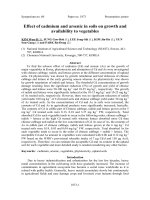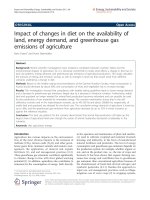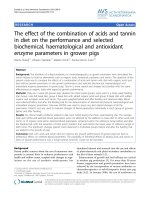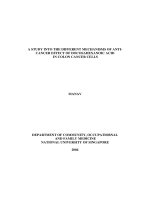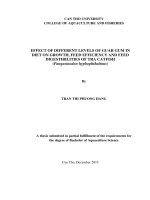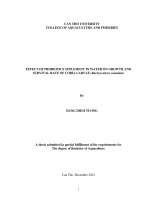effect of different levels of guar gum in diet on growth, feed efficiency and feed digestibilities of tra catfish (pangasinodon hyphophthalmus)
Bạn đang xem bản rút gọn của tài liệu. Xem và tải ngay bản đầy đủ của tài liệu tại đây (418.43 KB, 12 trang )
CAN THO UNIVERSITY
COLLEGE OF AQUACULTURE AND FISHERIES
EFFECT OF DIFFERENT LEVELS OF GUAR GUM IN
DIET ON GROWTH, FEED EFFICIENCY AND FEED
DIGESTIBILITIES OF TRA CATFISH
(Pangasinodon hyphophthalmus)
By
TRAN THI PHUONG HANG
A thesis submitted in partial fulfillment of the requirements for
the degree of Bachelor of Aquaculture Science
Can Tho, December 2014
CAN THO UNIVERSITY
COLLEGE OF AQUACULTURE AND FISHERIES
EFFECT OF DIFFERENT LEVELS OF GUAR GUM IN DIET ON
GROWTH, FEED EFFICIENCY AND FEED DIGESTIBILITIES
OF TRA CATFISH (Pangasinodon hyphophthalmus)
By
TRAN THI PHUONG HANG
A thesis submitted in partial fulfillment of the requirements for
the degree of Bachelor of Aquaculture Science
Supervisor
MSc. TRAN LE CAM TU
Can Tho, December 2014
EFFECT OF DIFFERENT LEVELS OF GUAR GUM IN
DIET ON GROWTH,FEED EFFICIENCY AND FEED
DIGESTIBILITY OF TRA CATFISH
(Pangasinodon hyphophthalmus)
Tran Thi Phuong Hang
College of Aquaculture and Fisheries, Can Tho University
ABSTRACT
The study determined the effects of different guar gum (GG ) levels addition in diets on growth
performance and feed efficiency and feed digestibility of Tra catfish (Pangasionodon
hypophthalmus).T h e experiment was set up consisting of 6 feeding diet treat ments with 6
different levels of guar gum addition (0, 0.025, 0.05, 0.1, 0.2 and 0.3%) with 3 replications per
treatment and completely randomized design. Experimental fish with average weight of
95.04±0.14g were stocked in 170L tank with the density of 20 individual/tank. The growth
performance was calculated basing on the initial weight, final weight, and survival fish. After
20 days of culture, the results showed that ADC (apparent digestibility coefficience) of feed of
the treatment diets 0.025,0.05 and 0.1% GG(78% ,77% and 77% respectively) were not
significantly different (P>0.05)compared to the treatment without GG (79%). Similarly, the
ADC of protein, ADC of lipid, ADC of ash in treatment diets were not significantly different
(P>0.05) as opposed to the treatment without GG. It noticed that at GG0.2 and GG0.3 had
significant effect of feed digestibility. However, the weight gain and PER (protein efficiency
ratio) decreased tendentiously with the increasing of GG levels addition in diets. In contrast,
the survival rate was not affected by GG addition diet treatments. In conclusion, the suitable of
GG level addition in diet forTra catfish was 0.05% at this level not only did not affect on
growth, feed efficiency and feed digestibility but also helped to improve faecal
characteristics.
Keywords:catfish, guar gum, growth
Title:Effect of different levels of guar gum in diet on growth, feed efficiency and feed
digestibility of Tra catfish (Pangasinodon hyphophthalmus)
1. INTRODUCTION
Tra catfish (Pangasinodon hyphophthalmus) is one of popular aquaculture species in the
Mekong Delta. With the advantages in topography, weather and many researches on
breeding and rearing techniques Tra catfish are the most interesting species on farming
culture in Vietnam in general and in Mekong Delta particularly. Catfish farming plays
an important role in aquaculture (PhươngandOanh,2010). Besides that, in recent years
Tra catfish consumed markets are hindered in many countries because of some barriers:
chemical contamination, meat quality, taxes. With the current situation of Tra catfish
culturing, sustainable development is crucial. It means that each stage in the culture
process should be considered to minimize negative effects to environment.
To begin with the life stage, fish excrete huge number of waste to environment. Some of
it are able to harm to the fish and their environmental life (Baird et al., 1996; Bergheim
and Åsgård, 1996) and some of it could eliminate by the machine, but this method was
useful when the size of dispersion was big enough (Cripps and Bergheim, 2000;
1
Bergheim and Brinker, 2003).Adding binder into the feed is the appropriate solution.
The binder plays an important role in increasing the viscosity and stability of the feces.
The binder can reduce the dispersion of toxic compound such as ammonia, nitrate and
nitrite (Thanapa Janphirom et al., 2010). Since 1987, Storebakken & Austreng used
alginate in Rainbow trout (Oncorhynchus mykiss), Shiau et al 1988 also discussed how
Carboxyl methylcellulose (CMC) affected to Tilapia. Brinker also had two researches on
how guar gum affect on rainbow trout (Oncorhynchus mykiss) in 2007 and 2009.
Nevertheless, binder such as guar gum, alginate even with low concentrations negatively
affected on Rainbow Trout growth, digestibility (of both protein and fat), feed intake
(Storebakken, 1985). Alginate was precipitated as alginic acid at pH values below 3 but
guar gum was also active as a binder at the pH values present in the stomach (Rosenlund
and Utne, 1981).
Guar gum is derived from the endosperms of the Idian cluster bean (Cyamoposis
tetragonolobus) and is water-soluble polymer of β-1,4-D-mannose and β-1,4-Dgalactose with some α-1,6 side chains. The –OH groups are responsible for viscosity,
making guar gum useful as a thickener (Trond Storeebankken, 1984) or primarily the
ground endosperm of the seeds from Cyamopsis tetragonolobus(L.) Taub. (Fam.
Leguminosae) mainly consisting of high molecular weight (50,000-8,000,000)
polysaccharides composed of galacto mannans; mannose:galactose ratio is about 2:1.
The seeds are dehusked, milled and screened to obtain the ground endosperm (native
guar gum). The gum may be washed with ethanol or isopropanol to control the
microbiological load (washed guar gum). Guar gum has white to yellowish – white
color. People use guar gum as thickener, stabilizer, emulsifier (FAO, 2005).
Figure 1: Guar gum structure (Source: FAO, 2005)
Guar gum is inert in nature and resistant to oil, greases, and solvents. It also had
excellent synergy with several other hydrocolloids, particularly xanthan gum (Ahmed et
al., 2005). It has a very high viscosity even when very little is used. The most important
property of guar gum is its ability to hydrate rapidly in cold or hot water to attain
uniform and very high viscosity at relatively low concentration and it also provides full
viscosity even in cold water.
The objective of the research “Effect of different levels of guar gum in diet on growth,
feed efficiency and feed digestibility of Tra catfish (Pangasinodon hyphophthalmus)” is
2
how guar gum affects on growth, feed digestibility and nutrients digestibility of Tra
catfish, giving more information for the next research to set up the feed formula more
effective to reduce the feed cost, friendly environment and high production.
2. MATERIALS AND METHODS
2.1 Experimental Diet
Table 1: Ingredients content in experimental diet
Ingredients
Fish meal 65
Defatted soybean meal 50
Extracted rice brans
Defatted Rice bran
Cassava
Sunflower meal
Fish oil
Premix vitamin-mineral
Marker
Chemical compositions
Crude Protein
Crude Fat
Crude Ash
Starch
Acid Detergent Fiber
Acid Detergent Lignin
g/kg Diet
142.9
168.1
151.8
162.3
160.2
170.2
24.5
10.0
10.0
g/kg diet
280.0
70.0
97.9
198
91.7
29.2
For the first step of making feed was crudemixing all the ingredients together: fishmeal
65 (Kien Giang), ricebran (local), cassava (local), defattedsoybeanmeal 50 (Argentina)
defattedricebran (Cai Lan company), sunflowermeal (South America) according to
weights in the formula.
Afteringredients were mixed, the mixture was ground through the mesh size of 0.8 mm.
Continuously, it was mixedwith guar gum at different levels (0%, 0.025%, 0.05%, 0.1%,
0.2% and 0.3%), Cr2O3, premix minerals and vitamins and fish oil (Chile). Then the
experimental diets were extruded into pellet then dried and stored.
Table 2: Chemistry characteristics of feed ingredients
Treatmets
GG0
GG0.025
GG0.05
GG0.1
GG0.2
GG0.3
Chemistry characteristic of feed ingredients
Moisture (%) Protein(%) Lipid (%)
Ash (%)
11.7
29.1
5.88
11.3
9.84
28.7
5.75
11.2
12.3
30.2
5.81
11.2
11.1
29.1
5.74
11.2
10.2
28.9
5.71
11.3
11.1
28.9
5.84
11.3
2.2 Experimental system and animals
The experiment lasted six weeks at The College of Aquaculture and Fisheries, Can Tho
University. Healthy and non-infectious stripped catfish juveniles were taken from
3
artificial hatchery in Tra vinh province with the size 95±0.14 g. The experiment
concluded of 18 composite settling tankswith the total volume of 170L/tank. The
stocking density was 20 individuals / tank. The experiment had 6 diet treatments and 3
replications per each with different levels of guar gum (0, 0.025, 0.05, 0.1, 0.2, 0.3%)
and completely randomized design. Chromium (III) oxide was used as external marker
(1%). Environmental conditions were checked everydaysuch astemperature twice a day
(in the morning and in the afternoon), D.O and pH once a week (in the morning and in
the afternoon).
2.3 Experimental procedure
− Fish housing and rearing: Tra catfish juveniles were stocked in the 10m3 tank for
adaptation to experimental conditions for two weeks after that fish were fed with six
treatment diets one time per day at 09:00am untilsatiation.
2.4 Samples collection:
− Initial weight and final weight were recorded before and after finishing the
experiment for growth rate evaluation.
− Uneaten feed collection: uneaten feed were collected after feeding time 30
minutes, dried at 60oC, and weighed (this wascarriedoutdaily).
− Feces collection:
Settled feces in the bottles were collected before feeding time (at 8:00am), wetweighted, dried, dry-weighted, and stored in the freezer with condition is -200C until
analyzing. After feeding 30 minutes, uneaten feed were collected and then the bottles of
the settling tank were connected into the middle of the last part of the tanks. These
bottles were immerged into the ice boxes so as to keep the temperature of collected feces
below 4oC. Next, the connected vales between faecal collected bottles and settling tanks
were opened and the whole system was leaved for nearly 22 hours for settling feces.
2.5 Chemical analysis, calculation and analysis static
All the parameters of chemical compositions such as dry matter, crude protein, crude
lipid and crude ash were determined by the method of AOAC (2000). Dry matter:
sampleswere dried in oven at 105oC unttable weight; crude protein: using Kjeldahl
method after acid digestion; crude fat: using Soxhlet method after ethyleth erextraction;
crude ash: samples after drying were burnt in furnace at 550-5600C in 4 hours until the
samples had white color for ash determination. Cr2O3 was measured by a
spectrophotometerat the wave length 350 nm after digested by nitric acid then perchlori
cacid (Furukawa and Tsukahara, 1966)
All the data were calculated by Microsoft Excel 5.0 and differences of data between six
treatment diets determined by using one way ANOVA (Duncan test) at significant level
0.05 of SPSS 16.0.
Survival rate (%)(SR)
4
Weight gain (g) (WG)
WG = Wt – Wo
Dailyweight gain (g) (DWG)
Feed conversion ratio (FCR)
FCR =
Protein Efficiency Ratio (PER)
PER =
Apparent digestibility coefficient nutrient (ADCNu)
ADCnu: nutrient digesibility
A: % of marker in food
B: % of marker in feces
A’: % nutrient in feed
B’: % nutrient in feces.
3. RESULTS AND DISCUSSION
3.1 Experimental Environment
Temperature is one of important factors effect to daily of fish. It affects to growth rate,
nutrition, breeding and disease of fish. When temperature get high fish more active on
metabolism and when temperature get low fish get shock, less feed is consumed and
low growth rate (ĐỗThị ThanhHương,2000)
During the experiment, the environment factors were stable and no differences between
six diet treatments. The lowest temperature was 28.40C in the morning and highest
temperatures was 30.70C in the afternoon while pH was nearly to steady from 7.5 in the
morning – 7.6 in the afternoon during the experiment.
Table 3: The variation of environmental factors during the experiment
Treatment
GG0
GG0.025
GG0.05
GG0.1
GG0.2
Temperature (0C)
pH
D.O (mg/L)
Morning
Afternoon
Morning
Afternoon
Morning
Afternoon
28,40,04
28,40,05
28,50,06
28,40,02
28,50,07
30,70,22
30,60,03
30,70,12
30,60,08
30,60,07
7,50,05
7,50,01
7,50,02
7,50,08
7,50,02
7,60,08
7,60,02
7,60,04
7,60,06
7,60,02
5,930,43
5,840,17
6,090,09
5,850,42
6,140,23
6,050,37
6,230,06
6,380,05
6,060,33
6,340,13
5
GG0.3
28,40,07
30,60,08
7,50,06
7,60,03
5,850,38
6,070,32
Value are mean ±SD of triplicate (n=3)
In addition, dissolve oxygen level ranged from 5.85 to 6.38 because of flow through
system and aeration. In conclusion, all of the environment factors according to Boyd
(1998) pH from 6-9, temperature from 25oC to 320C and dissolve oxygen at least 5mg/l
were suitable for growth of Tra catfish.
3.2 Survival rate and Growth performance
3.2.1 Survival rate
There were no significant differences in survival rates between diet treatments. Its
Table 4: The survival rate of Tra catfish during the experiment
Treatment
SR (%)
GG0
98.3± 2.89
GG0.025
a
98.3± 2.89
GG0.05
a
a
100± 0
GG0.1
96.7± 2.89
GG0.2
a
a
100± 0
GG0.3
98.3± 2.89
a
Mean values in same row with different superscript letters are significantly different
(P<0.05). Value are mean ±SD of triplicate (n=3)
value ranged from at least 96.7%to 100% (Table 4). It indicated that guar gum did not
affect to survival rate of fish. This result was similar to the research of Brinker in 2009
on rainbow trout (Oncorhynchus mykiss) on improving the mechanical characteristics of
fecal waste and influence of fish size and NSP-guar gum. The fish developed normally
and there were no visible signs of intestinal irritation or pathology that could have been
attributed to the inclusion of dietary binder.
3.2.2 Growth performance
The growth performance of Tra catfish that were fed the different levels of guar gum is
presented in Table 5 had no significant difference.
Table 5: The growth performance of Tra catfish during experiment
Treatment
GG0
GG0.025
GG0.05
GG0.1
GG0.2
GG0.3
Wi
95.0±0.12 a
95.0±0.19 a
95.0±0.10 a
a
95.0±0.20
95.0±0.06 a
95.0±0.16 a
Wf
113.6±2.4 a
112.6±5.8 a
110.8±1.4 a
a
111.0±3.0
110.0±2.0 a
110.6±3.6 a
WG
18.6± 2.42a
17.6± 5.70a
15.8± 1.38a
a
15.8± 3.14
15.0± 2.03a
15.5± 3.73a
DWG
0.98± 0.13a
0.93± 0.30a
0.83± 0.07a
a
0.83± 0.17
0.79± 0.11a
0.82± 0.20a
Mean values in same row with different superscript letters are significantly different
(P<0.05). Value are mean ±SD of triplicate (n=3)
With the same initial weight 5.0±0.14g after six weeks treatment GG0.2 had the lowest
final weight of 110±2.0 while treatment without guar gum (GG0) had the highest final
weight (113.6±2.4) compared to the treatment without GG. At the levels GG0.025,
GG0.05, GG0.1, GG0.2 and GG0.3, the final weight decreased lightly but were not
significant difference (P>0.05) and this trend was similar to growth rates (WG and
DWG). Particularly, in weight gain, the treatment without GG were 18.6g while
GG0.025, GG0.05, GG0.1,GG0.2 and GG0.3 were 17.6g, 15.8g, 15.8g, 15g and 15.5g in
respectively. Similarly, daily weight gain also decreased with the increasing of GG
levels in the diets but it was not clearly between each treatment because of limited
experimental time (only six weeks) as opposed to at least eight weeks when the
6
experiment fish could show the difference in growth (Tran Thi Thanh Hien and Nguyen
Anh Tuan, 2009)
3.3 Feed Efficiency
FCR (feed conversion ratio) plays an important role in aquaculture. The feed conversion
ratio (FCR) or feed conversion efficiency (FCE), to define it simply, is a measure of an
animal’s efficiency in converting feed mass into increased body mass.
There were no significant differences in feed efficiency (FCR and PER) between
treatments (P>0.05). The FCR increased with the increase of GG level 0.99, 1.04, 1.07,
1.13, 1.23 and 1.23 with GG level from 0, 0.025, 0.05, 0.1, 0.2, 0.3, respectively.
Table 6: Effect of different level GG on FCR and PER during the experiments
Treatment
FCR
PER
GG0
GG0.025
GG0.05
GG0.1
GG0.2
GG0.3
0.99± 0.14a
1.04± 0.27a
a
1.07± 0.09
1.13± 0.27a
a
1.23± 0.16
a
1.19± 0.34
3.52± 0.53a
3.53± 1.03a
a
3.12± 0.27
3.13± 0.66a
a
2.85± 0.39
a
3.08± 0.82
Mean values in same row with different superscript letters are significantly different
(P<0.05). Value are mean ±SD of triplicate (n=3)
Especially, the FCR at GG0.05 and GG0.1 compared to GG0, they were all no
significantly different and these levels of GG helped to improve the fecal characteristic
(Pham Minh Tam, 2014). He reported that at the levels of GG 0.05% and 0.1% benefited
bigger size of feces but not affected on FCR. The opposite was almost true of the values
of PER, it decreased with the increasing of GG levels.
3.4FeedDigestibilities
Table 7: The feed digestibility and nutrients digestibility of Tra catfish during the
experiment
Treatment
GG0
GG0.025
GG0.05
GG0.1
GG0.2
GG0.3
ADC Feed
0.79± 0.01c
0.78± 0.02bc
0.77± 0.01bc
0.77± 0.02bc
0.76± 0.01ab
a
0.74± 0.03
ADCprotein
0.89 ± 0.01d
0.88± 0.2cd
0.88± 0.1cd
0.88± 0.2bc
0.87± 0.03b
a
0.86± 0.01
ADClipid
0.96± 0.01b
0.96± 0.01b
0.96± 0.01b
0.96± 0.01b
0.95± 0.02ab
a
0.94± 0.01
ADCash
0.45± 0.05c
0.40± 0.01bc
0.37± 0.01b
0.37± 0.01b
0.35± 0.02ab
a
0.29± 0.07
Mean values in same row with different superscript letters are significantly different
(P<0.05). Value are mean ±SD of triplicate (n=3)
First of all, the feed digestibility was no significant difference (P >0.05) between
treatment with levels of GG of 0, 0.025, 0.05and 0.1% (0.77 – 0.78) compared to the diet
without GG (0.79). However, the diets with levels GG of 0.2 and 0.3 had the ADC of
feed of 0.74 which were significantly different (p<0.05) from the diet without GG (Table
7).
Similarly, the ADC of protein at levels of GG addition of 0.2 and 0.3 (0.86 – 0.87) were
7
significant difference (P<0.05) from the diet without GG (0.89)whereas other diets such
as GG0.025, GG0.05 and GG0.1 had no significant differences as opposed to GG0and
all of them ranged from 0.88 to 0.89.
The ADC of lipid had no significant difference between the diets GG0.025, GG0.5, GG
0.1, GG0.2 compared to diets GG0 (0.95 – 0.96 versus 0.96). Once GG levels addition
increased to 0.3%, the difference was significant to other levels except for 0.2%.
The result of this experiment was similar to that of Leenhowers’ rearch in 2006 on
African catfish (Clarias gariepinus). His research determined the effect of GG addition
on nutrients digestibility. In general, ADC of dry matter, protein, and energy decreased
with increasing inclusion levels of guar gum. In addition, Thanapa Janphirom et
al.,(2010) on Channa Striata increased fish feed stability by using guar gum in his case
study. The study Channa striata were fed for 20 days with the basic diets, diets with
guar gum of 0.01%, 0.02% and 0.03%. The specific growth rate of juveniles Channa
striata was 90-95%. However, the SGR were 50.0%, 48.4%, 48.4% and 48.3% in basic
diet, diet with guar gum 0.01%, 0.02% and 0.03%, respectively. The reason why SGR
with diets with guar gum addition was lower than that without guar gum addition, since
guar gum was indigestible and may obstruct the absorption of nutrients of the fish
especially fat, which is one of the most important nutrients for growth. Lastly, at level of
GG addition was 0.05 not only had result on improving the characteristics of feces but
also not affecting on growth, feed efficiency and feed digestibility of fish. According to
all results of the study, the level of GG 0.05% was the suitable choice for improving the
feces and economic efficiency.
4. CONCLUSION
The suitable level of guar gum addition in feed was 0.05%. At this level, there was no
effecton survival rate, growth performance, and feed digestibility of fish
ACKNOWLEDGEMENTS
I would like to say thanks to Ms. Tran Le Cam Tu, Mr. Cong and Mr. Tam, Mr. Quan.
Ms Tran, Ms Yen and all of my classmates from Advance Aquaculture Program course
36 for supporting and advising to me during the research. Sincerely thanksto all the staff
of College of Aquaculture and Fisheries for teaching me and provide good conditions for
me to study. Lastly, thanks to my advisor Ass. Professor Dr. Ngo Thi Thu Thao for
being with me during a long time.
REFERENCES
AOAC, 2000. Official Methods of Analysis. Association of Offical
AnalyticalChemistArlington
Amirkolaie k. Abdolsamad, Johan A.J.Verreth, Johan W.Schrama, 2006. Effect of
gelatinization degree and inclusion level of dietary starch on the
characteristics of digesta and faeces in nile tilapia(Oreochromis niloticus),
Aquaculture 260 (2006) 194-205.
Ahmed, J.; Ramaswamy, H.S. ; Ngadi, M.O.(2005). Rheological characteristics of
Arabic gum in combination with guar and xanthan gum using response surface
methodology: Effect of temperature and concentration. International Journal of
Food Properties, Vol. 8, No. 2, (April 2005), pp. 179-192, ISSN 1094-2912
8
Baird, D.J., Beveridge, M.C.M., Kelly, L.A., Muir, J.F., 1996. Aquaculture and Water
Resource Management. Blackwell Science Ltd.,Oxford. 219pp.
Bergheim, A., Åsgård, T.,1996. Waste production from aquaculture. In:Bair, D.J.,
Beveridge, M.C.M., Kelly, L.A., Muir, J.F.(Eds.), Aquaculture and Water
ResourceManagement. Blackwell Science, Stirling, pp.50–80.
Bergheim, A., Brinker, A.,2003. Effluent treatment for flow through systems and
European environmental regulations. Aquac. Eng. 27, 61–77.
Brinker (2007).Guargum in rainbow trout(Oncorhynchus mykiss) feed: The influence of
quality and dose on stabilisation of faecal solids. Aquaculture 267 (2007) 315327.
Brinker (2009). Improving the mechanical characteristic of faecal waste in Rainbow
Trout: the influence of fish size and treatment with a non – starch polysaccharide
(Guar gum), Aquaculture Nutrition 2009 15; 229 - 240
Boyd, C.E, 1998. Water quality for ponds for aquaculture. Research and
Development Series No.43, August 1998, Alabama,37pp.
Cripps,S.J.,Bergheim,A.,2000. Solids management and removal for intensivel andbased aquaculture productions systems. Aquac. Eng.22,33–56.
Đỗ Thị Thanh Hương, 2000. Giáo trình sinh lý động vật thủy sản. Khoa Thủy sản.
Trường Đại Học Cần Thơ.
Furukawa and Tsukahara (1966). Chromium
oxidate determination. Bull.
Japan.Socicial scientific Fishies,N.32, 502-506
Leenhouwers 2006. Digesta viscosity, nutrient digestibility and organ weight in African
catfish (Clarias gariepimus) fed diets supplemented with different levels of a
soluble non – starch polysaccharide, Aquaculture Nutrition 2006 12; 111-116
Lê Thanh Hùng, 2008. Thức ăn và dinh dưỡng thủy sản. Nhà xuất bản Nông nghiệp
Thành phố Hồ Chí Minh. 299 trang.
Pham Minh Tam, 2014. Effect of guar gum levels on digestion and feces characteristic
of catfish (Pangasionodon hypophthalmus).
Phan-Lam, T., Bui Tam, M., NguyenThuy, T.T., Gooley GeoffJ., Ingram Brett A.,
Nguyen Hao V., Nguyen Phuong, T.DeSilva SenaS.(2009). Current status of
farming practices of striped catfish, Pangasianodon hypophthalmus in the
Mekong Delta,Vietnam. Aquaculture, 296:227-236.
Phuong, N.T.,& Oanh, D.T.H.(2010).Striped Catfish Aquaculture in Vietnam:A Decade
of Unprecedented Development Success Stories in Asian Aquaculture. In
S.S.Silva & F.B.Davy (Eds.), (pp.131-147): Springer Netherlands.
Rosenlund, G. and Utne, F., 1981. Bindemidler i &for til fisk.
Fiskeridirektoratets Vitamininstitutt, Bergen, Norway. Rapporter og
Oversikter, No. 13 A/B, 56 pp.
Shi-Yen Shiau, Hao-Ling Yu, Sophy Hwa, Shih-Yang Chen and Song-ing 1988, The
influence of Carboxymethylcellulose on growth, digestion, gastric emptying time
and body composition of Tilapia. Aquaculture, 70 (1988) 345-354
Summerfelt,S.T.,1998.An integrated approach to aquaculture waste management in
flowing water systems. In:Libey, G.S., Timmons, M.B.(Eds.), The Second
International Conferenceon Recirculating Aquaculture. Virginia Polytechnic
Institute and State University, Roanoke, Virginia USA ,pp. 87–97.
Thanapa Janphirom, Pawinee Chaiprasert, Todsaporn Thongthieng, Sasitorn
Suwannathep and Warinthorn Songkasiri4, 2010. Increasing fish feed stability
9
using guargum: casestudy with Channa striata. Asian Journal of Food and AgroIndustry, 363-370.
Trần Thị Thanh Hiền và Nguyễn Anh Tuấn, 2009. Giáo trình Dinh dưỡng và thức ăn
thủy sản. Khoa Thủy sản, trường Đại học Cần Thơ
Trond Storebakken, 1985. Binder in fish feeds I. Effect of alginate and guar gum on
growth, digestibility, feed intake and passage through the gastrointesnal tract of
Rainbow Trout, Aquaculture, 47 (1985) 11-26
Trond Storebakken and Erland Austreng, 1987. Binders in Fish Feeds II. Effect of
Different Alginates on the digestibility of macronutrients in Rainbow Trout,
Aquaculture, 60 (1987) 121-131
10
